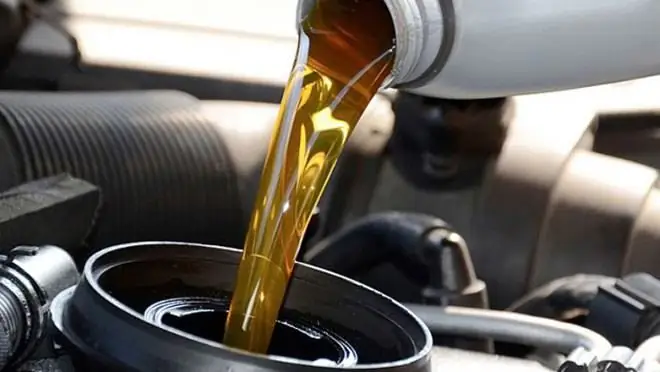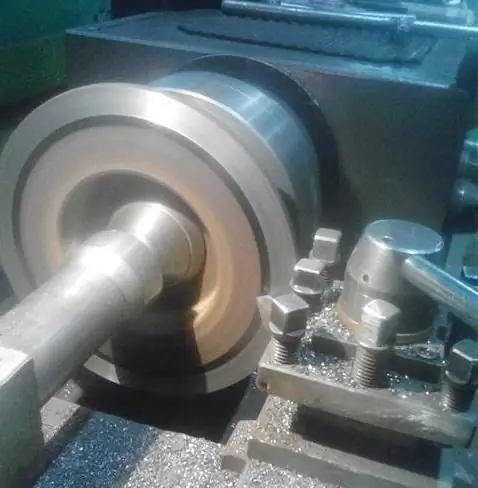2026 Author: Erin Ralphs | [email protected]. Last modified: 2025-01-22 21:14:16
Every motorist has at least once heard of the existence of magnesium alloy wheels. They are known, but not as much as the same steel or aluminum ones. Meanwhile, magnesium discs can boast a whole range of undeniable advantages that significantly improve the quality of operation of both the discs and the car. Let's look at all the pros and cons of products from these alloys.
Features of alloy wheels
The main plus of a light-alloy product, no matter if it is made of aluminum alloy or with the addition of magnesium, is a mass that is much less than the weight of a stamped disc. Also cast wheel element is more durable, higher resistance to corrosion. And the most important plus is that the alloy wheel has a more aesthetic appearance.

With the weight, everything is clear - the weight is lower due to the use of lighter alloys. Strength and resistance to corrosion is also a consequence of the materials used and production technology. So,the alloy wheel is able to withstand fairly large loads without any serious damage. If the surface is damaged, there will be no rust. As for the appearance, it all depends on the matrix - you can create thousands of different forms. By painting in different colors, you can achieve a very spectacular appearance.
The alloy wheel also has a few disadvantages. With high strength, the product has low ductility and brittleness. In addition, in the event of cracks, the repair of the product is laborious and the price of work is quite high. An element made of light alloys is able to withstand significant impacts, but if the impact force is greater than the capabilities of the disk, then it will not only deform, but will crack or split. Strength is also not a plus, but rather a minus. When the wheel hits, the energy is then transferred to the car's suspension completely.
Advantages of magnesium products
Calling magnesium discs an innovative solution is not worth it - these materials have been used for a very long time and with great success in various areas of modern industry. The automotive industry was no exception. If we talk about specific products, then magnesium wheels have managed to wind tens of thousands of kilometers since the first appearance on the market. But it also cannot be said that magnesium alloys will soon replace traditional steel forgings and aluminum products.
ML5 alloy is used for the production of discs. This is a cast magnesium alloy. It has been widely used for the production of compressor housings, crankcases, pumps, brake housingssystems and other details. According to the technical characteristics, ML5 is closest to the AL2, AL4, AL9 silumin alloys. The main advantage of ML5 is the density reduced by 33% compared to AL4. The same product with the same density will be one third lighter than a part made of silumin.
Along with a lot of positive qualities, magnesium alloy wheels also have a number of disadvantages, so the choice of one or another option is subjective. If the car owner has not encountered such products, then he should be aware of these disadvantages and advantages.
Lightweight
As in the case of cast aluminum wheels, the main advantage of the aluminum-magnesium alloy is its relatively low weight, as well as all the other advantages associated with this. The lightness of the disc allows the car to drive better, and the ride itself will be more comfortable. Steel wheels have a mass 4 times greater than a magnesium wheel. Titanium products weigh 2.5 times heavier. Even aluminum lose magnesium in weight. The material has a weight one and a half times less than the weight of aluminum.

Design
Due to the fact that magnesium has a unique structure, manufacturers can experiment with the shape of the disc as they please. You can get a unique design that can never be achieved using other materials, and if you do, then you have to lose in technical characteristics or structural strength. Polished magnesium wheels look especially impressive. The alloy has golden impurities that look flawless.
Absencemetal fatigue
Unlike aluminum or steel, magnesium alloys are not subject to fatigue. If the disk is subjected to medium and low loads, the metal is able to keep its technical characteristics for a very long time.
Elasticity
The material is very elastic and this allows it to keep the shape specified by the manufacturer. Due to this elasticity, the disk is easier to break than to bend. This suggests that potholes and minor bumps on the curbs will not be terrible for the wheels.
Thermal conductivity
She's very tall here. What does it give? Magnesium rims are able to absorb the temperature of the brake disc and hub. You can significantly extend the service life of parts of the brake system, as well as improve the quality of the braking process.

Cons
These discs have a lot of advantages. And if everything is so good, why are magnesium rims selling so poorly? All this is due to existing shortcomings.
Poor corrosion resistance
It is said above that the non-ferrous aluminum alloy cast wheel has high corrosion resistance, but this is not about magnesium. Even after summer, the rim is able to lose surface integrity and strength. In winter, a real test begins for magnesium wheels - these are constant temperature changes, high humidity, s alt and reagents. All this together and separately can easily destroy the metal. The only way out is to apply special coatings to the disc. But what is missing is the unique look that only alloy magnesium wheels have.

Features of magnesium
Another significant disadvantage is that steel parts and magnesium alloys are very easy to enter into a chemical reaction, during which the result is the destruction of magnesium. Mounting such a disc requires a special approach and often additional costs for components.
Elasticity
Above in the list of benefits, it was about elasticity. The disk can be quickly broken, split. than bend. On domestic roads, there are a lot of chances to get a wheel into a deep hole. These are cast aluminum wheels, but it should be clarified that this is more true for magnesium products - the metal structure here has a large grain size and brittleness.

Forged magnesium disc is made by hot stamping technology. In terms of strength, it is practically in no way inferior to aluminum or titanium. The strength is even higher than titanium, while maintaining ductility and increased resistance to corrosion. But these products are much more expensive than cast ones.
High cost
Previously, magnesium alloys were only available for the aviation and space industries. However, then the material became cheaper and began to be used in the automotive industry. But even taking into account this reduction in price, the cost of disks is quite expensive. This is true for imported forged products made from prepared quality blanks.
Magnesium in the USSR
Magnesium wheels were even in the USSR. They were produced at defense enterprises and operated by Soviet racing drivers. Information aboutthere are very few of these wheels, but it is still there.

In the mid-1980s, the KULZ plant in Kamensk-Uralsk began production of VAZ KA-85 Vesna magnesium discs. They were intended for the AvtoVAZ 01-05 classic line. From 85 to 87, the company produced 400 sets. In 1987, the model range of the plant was replenished with a line of disks for the VAZ-08 "Secret". In 1989, KA-89 "Comfort" discs began to be produced. The weight of each wheel is no more than five kilograms. Now such products can only be found in the secondary market.

Conclusion
So we've looked at magnesium alloy wheels. What characteristics they have is also already clear. Today, SMZ magnesium discs can be found on sale. This is a domestic enterprise in Solikamsk. Despite the weak demand for these products, the plant produced a lot of various models of rims, which today can be found at reasonable prices on Avito and similar sites.
Recommended:
Automotive oils 5W30: rating, characteristics, classification, declared qualities, advantages and disadvantages, reviews of specialists and car owners

Every car owner knows how important it is to choose the right engine oil. Not only the stable operation of the iron “heart” of the car depends on this, but also the resource of its operation. High-quality oil protects mechanisms from various adverse effects. One of the most popular types of lubricants in our country is oil with a viscosity index of 5W30. It can be called universal. The 5W30 oil rating will be discussed in the article
Where and how to pierce brake discs? Grooving of brake discs without removal

The brake system of a car requires regular maintenance. In particular, this applies to replacing brake pads, inspecting discs for defects, changing fluid, etc. But far from always this is done on time and is done at all. Many turn to the service station only in case of obvious malfunctions. But all this can be avoided if you change the pads in a timely manner and do not forget to grind the brake discs
Carburetor and injector: difference, similarities, advantages and disadvantages of carburetor and injection engines, principle of operation and expert reviews

For more than a hundred years, the car has firmly established itself in our lives. During this time, managed to become a familiar, everyday means of transportation. Let's see what the difference is between a carburetor and an injector, what advantages and disadvantages they have
Motor all-terrain vehicle "Barkhan": characteristics, operation, advantages and disadvantages

The domestic all-terrain vehicle "Barkhan" is designed to move people and goods in snowy or wetlands. The unit is able to overcome deep drifts, as well as clay and peat impassability. In addition, the tricycle is able to drive through trenches, slopes and dumps filled with a viscous mass to a depth of 30 centimeters
Ford Mondeo car: owner reviews, description, characteristics, advantages and disadvantages

The advantages of the Ford Mondeo for the Russian buyer are obvious. A solid and representative car is characterized by reckless handling and good dynamic characteristics, spacious and comfortable, neatly assembled, reliable and economical. And it costs significantly less than its competitors

